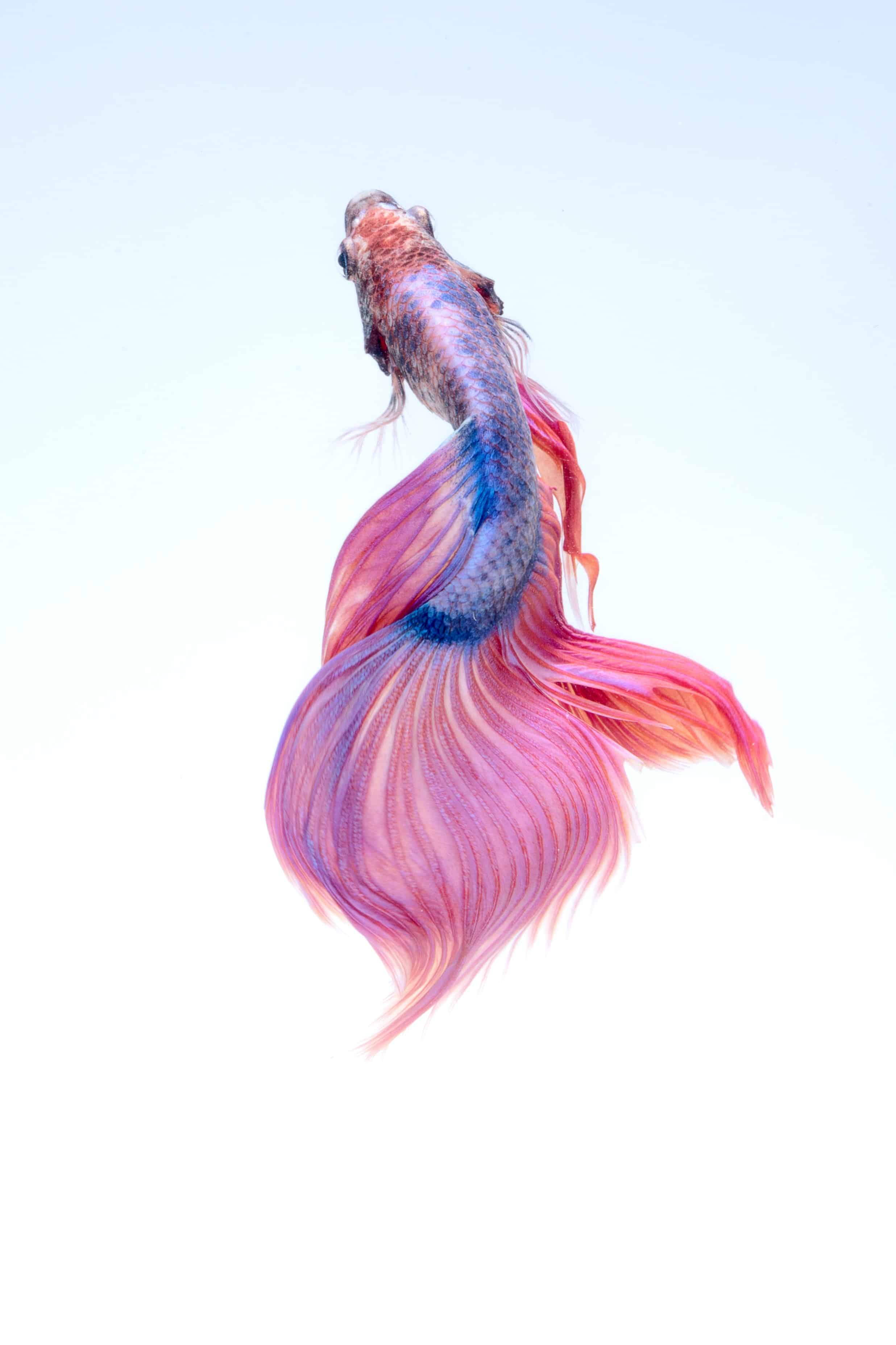Last Updated on October 8, 2020
Having a pet Betta fish is one of the first things that get people into the hobby. You pass by a pet store and see their 5-gallon display aquarium with lots of pretty decoration, outstanding plants, and that cute little fish with flowing fins looking back at you.
You wonder why it’s alone in its tank and the fish store seller tells you more about the magnificent Betta fish. The quirky character fascinates you, and now you want to have one too! Just like with any pet you will probably ask, “How long does a Betta fish live?”
Table of Contents
Average Lifespan of Betta Fish
The Betta fish has an average lifespan of 2 to 3 years. This is on average so it can live longer provided that we give all its needs.
With the right genetics, environment, and care from the onset of a betta’s life, they can live up to 6 or 7 years or more. Stories of Betta fish living to 9 and 10 years seem very rare.
Betta fish are most of the time the first pet of a first-time fish keeper, which makes it unfortunate because the situation rarely allows much preparation. Not much studying and researching happened before the actual purchasing (or gift-giving). So this drastically puts the lifespan of the Betta at risk.
Lifespan In the wild
The Betta fish in the wild has an average lifespan of 2 years. This may seem shorter than that of Bettas in captivity because the competition in the wild makes things less certain for Betta fish.
You should take note though that the Betta fish you see being sold in fish stores are usually from breeders. Years of breeding for selected characteristics such as gill color, size, and patterns have produced multiple variations of Betta Splendens. The betta fish in the wild are less colorful compared to them.
Lifespan In confinement
Bettas in captivity as a pet have an average lifespan of 3 years. If given suitable conditions to thrive, a pet Betta can live longer compared to its wild counterparts. It would be good to ask your local fish store about the age of the Betta they are selling so you can have an estimate of how long they will be with you.
Without food
A betta fish can survive without food for 14 days.
When food is scarce, they rely on their fat stores for energy. This, however, should not be a constant situation for your Betta pet fish because it will stress them out and lead to being prone to disease.
Don’t panic if you forget to feed your fish for a day or two. The fish will withstand that with no negative effects.
Some Betta fish keepers recommend a day or two of fasting for Betta fish. Skipping a meal or two every once in a while will allow the betta fish’s digestive tract to empty its contents.
Related: How Do You Know If Your Betta Fish Is Dying
How to Prolong Betta Fish Life

House them in a recommended tank size
A Betta can live in a 1-gallon tank, but this is not a recommended size for beginners. The size is really too small for Bettas to thrive. Give your pet betta a tank with at least 5 gallons of capacity. A 5-gallon tank is optimal because it has enough water volume to prevent sudden fluctuations in water parameters.
Maintain water quality and temperature
The ideal water parameters for betta fish are as follows.
Temperature: 75° to 81°F (23.8° to 27.2°C)
Bettas are tropical fish. Providing a betta fish this temperature range encourages it to thrive. It is highly recommended to use aquarium heaters for maintaining this temperature range in your fish tank.
Small 1 gallon tanks will have more temperature fluctuation because of the small water volume. This is one reason such small containers aren’t recommended for a betta fish.
Ammonia and Nitrite: 0 ppm
Ammonia is toxic to fish. It increases when decaying matter such as fish waste, uneaten food, and dead leaves accumulate in the fish tank. Beneficial bacteria process ammonia into Nitrite. Nitrites are still toxic and are further broken down by these beneficial bacteria into Nitrate.
“Cycling” your fish tank before introducing a Betta is very important to establish this Nitrogen cycle.Just give the tank time. The cycling process usually takes six to eight weeks. After about eight weeks, your ammonia and Nitrite levels should be acceptable (about trace levels). You can then introduce your pet Betta.
Nitrate: <20 ppm
Performing regular water changes is the key to lowering nitrates. Replace with water that has little or no nitrate to lower the overall nitrate level in the aquarium. Keep nitrates low by performing partial water changes between 15% to 20% every week.
Hardness
You can divide this into two types:
- Degrees of general hardness (dGH or °GH): 3-4 dGH (50-66.7 ppm)
- Degrees of carbonate hardness (dKH or °KH, the K is from the German Karbonathärte): 3-5 dKH (53.6- 89.4 ppm)
Betta fish prefer softer water but can tolerate water hardness of 5-20 dH or 70-300 GH ppm.
pH (denoting ‘potential of hydrogen’ or ‘power of hydrogen): 6.5-7.5.
Betta fish prefer slightly more acidic water. The dark water in their natural habitat is caused by millions of leaves falling into waterways. As the leaves break down, they release tannins (tannic acid) which make the water dark brown.
We can do this in an aquarium by using Indian almond leaves which can lower the pH to the desired level.
Provide the right amount and quality of food
Provide food that’s high in protein and fiber. Betta fish need a high protein diet because they are carnivores. Insects, worms, mosquito larvae, and small crustaceans from their diet in their natural habitat. Some bettas won’t even eat regular tropical fish flakes high in carbs.
While betta pellets are a smart start, you should also be incorporating freeze-dried, frozen, or live bloodworms and brine shrimp to provide all the nutrients they need. Food made specifically for bettas is great as it has taken into consideration the natural diet of the fish and has mimicked the fish’s natural requirements.
Overfeeding is one problem in betta fish. Avoid overfeeding them, because it can lead to complications too. Constipation is a huge problem for pet betta which is usually caused by too much food.
Feeding 2 to 3 pellets once a day will be just fine. Feed the amount your Betta can eat within 2 minutes. A fasting day once a week can be set in the schedule to allow the digestive system of your Betta fish pet some time out.
Perform regular maintenance checks
It would be great to always have a master test kit on hand to check the basic water parameters such as Ammonia, Nitrite, Nitrate, and pH. These will help you figure out if the home of your Betta fish is a healthy environment for it to thrive. Weekly partial water changes of 15% to 20% will lower nitrate levels.
You can clean your filter once a month to remove any accumulated debris. Just make sure you do not use tap water to clean it! You can fill up a gallon jar with tap water and add a water conditioner to remove chlorine and chloramine. Use this treated water when cleaning your filter media.
A few squeezes until the water from the filter floss or sponge is more or less clear is a good sign that you have squeezed out most of the debris. Do not use water directly from the tap because this will kill the beneficial bacteria in your filter.
Avoid over-cleaning your Betta fish’s tank. A huge amount of water change may make sudden fluctuations in water parameters. Bettas are hardy creatures but they can get stressed too. Sudden changes in water parameters trigger stress. Stressed fish are more prone to disease. Always be on the lookout for signs of disease.
Keep a keen eye on your Betta fish’s scales, fins, and energy levels. Scales and fins should be clear of any spots and patches. A dull color, lack of appetite, lethargy, and change in swimming behavior may be a sign of disease. The disease will shorten the lifespan of a Betta fish.
